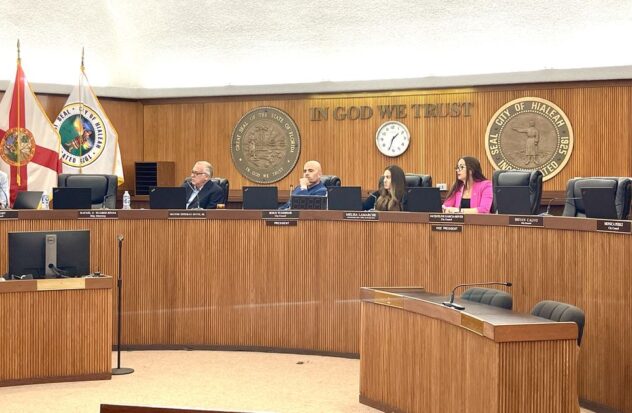MIAMI. – Esteban Bovo, mayor of Hialeah, chaired the third workshop on the impact of the migratory wave in that municipality in southern Florida, a meeting where, for the first time, some preliminary figures were unofficially revealed that demonstrate the large population increase in the city caused by the newcomers.
David Fernández, Marketing Director of Hialeah, explained in the workshop this Monday, April 15, some preliminary data obtained by the Placer.ai tracking application, which the Council approved to use as an alternative to conducting a census and more economically establishing the number of city residents, presumably affected by the recent wave of migration.
According to data provided by Placer.ai, last Saturday, March 23, from 7:00 am to 9:00 am in Hialeah there were about 263,000 people, most of whom spent an average of 17 hours in the city.
A similar figure was recorded that same day from 12:00 at night to 2:00 am when the technological application registered 265,000 people, who had spent an average of 17 hours in the city.
For its part, on Wednesday, April 20, from 7:00 am to 9:00 am, the application detected 243,000 people who had spent an average of 13 hours in Hialeah. That same day, from 12:00 at night to 2:00 am, the application registered 281,500 people who had stayed in the city for at least 14 hours.
Although the figures do not reflect the increase of 150,000 people that the mayor predicted, the preliminary numbers exceed the 224,000 residents recognized by the official census.
Placer.ai is a technology application that can determine the flow of people in a city or business by tracking the location of cell phones. Its analysis algorithm has access to 30 million electronic devices in the US and obtains geolocation data provided by the different applications installed on the devices.
These data are preliminary and unofficial. It’s just a sample. The process still needs to be adjusted further to establish the number of residents as accurately as possible, Fernández clarified.
The mayor of Hialeah said that he will take advantage of his trip this week to Washington, in which he will meet with Congressman Mario Díaz-Balart and Senator Marco Rubio, to address the issue related to the use of these technologies to determine the number of residents .
There are fears that the numbers provided by Placer.ai will not be enough to obtain new funding from the federal government.
“Congress can determine that these technologies are useful,” said Bovo, who regarding the usefulness of the data obtained by the application stated: “You want to be more aware of the people who access city services. That may mean that we have to put in more money.”
From the city’s point of view, Bovo maintained, it is the Council that plays the fundamental role. Depending on the data that finally comes out, “you may consider that more money is needed to try to buy land to build homes. It is his power.”
But the most important thing about this data, said the councilor, “is to share it, not only with the federal government, we must do it with the State and the county government, because the residents of Hialeah also pay taxes to the County and perhaps those funds, They have to start coming to the city more.” Ultimately, the responsibility for the influx of so many people who need help lies with the federal government.
Bovo flatly denied that the result of the workshop was to have the justification to raise taxes. “I don’t think there is a will in this Council to raise taxes. I am aware that we must live within the framework of what residents can afford. Even so, we have experienced budget growth due to the investments made. But that money is being invested immediately in important services so this city can continue to function.”
Regarding the importance of the workshops, Bovo insisted on reaching as close as possible to the number of real residents of the city.
“We know that the number of residents is much more than the 224,000 that the census reported. It is key to be able to reach the Federal government with some type of data that shows that we have 60 or 100 thousand people.”
However, Bovo acknowledged that Washington does not have to accept the numbers obtained through this application, but its responsibility as head of the city is to show “the reality that we are experiencing.”
Above all, he indicated, because “this exercise helps feed the argument that we have many more people than the census says. A reality that must be considered when talking about directing funds to cities.”
Also participating in the workshop were state senator Ana María Rodríguez, Miguel Inda-Romero, immigration lawyer, and Berta Cassidy, community relations specialist, who addressed the impact of immigration from different angles.
In the last two years, some 400,000 Cubans arrived in the United States, many of whom live in South Florida, especially in Hialeah.
Data compiled by an official census helps decide the distribution of federal government funds across communities, which with their multiple departments serve residents.
(email protected)






